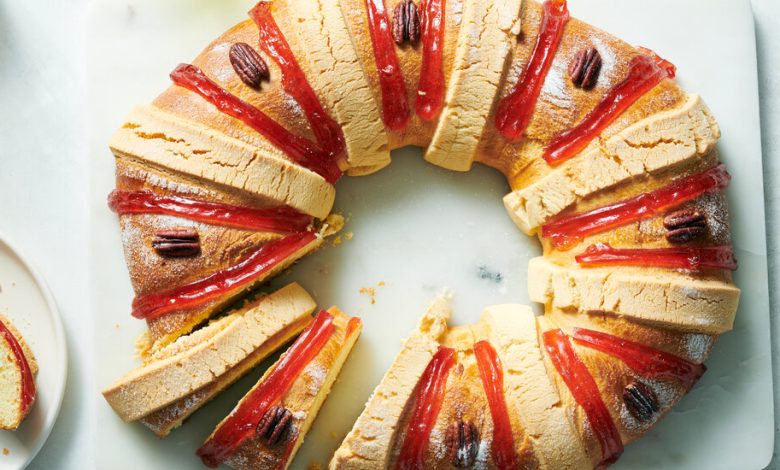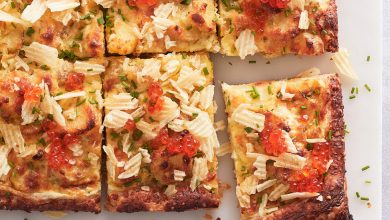These Bejeweled Treats Are a Must for Three Kings Day

Mexican bakeries begin their preparations for Día de los Reyes Magos, or Three Kings Day, weeks before the holiday’s Jan. 6 arrival. At La Monarca Bakery & Cafe in Los Angeles, bakers have been mixing and freezing bread dough since early December for the celebration’s signature treat: rosca de reyes, or three kings bread.
For many Latinos, Three Kings Day concludes the holiday season. People line up outside their favorite bakeries early in the morning to pick up a rosca to celebrate the day the Magi brought gifts to the baby Jesus. Families gather later in the evening and eat the sweet bread along with champurrado, café de olla or hot chocolate.
Recipe: Rosca de Reyes
This Epiphany bread likely arrived in Latin America in the 20th century when Spaniards fled to Mexico during the Spanish Civil War in 1936 and opened bakeries, where they served rosca. The highly symbolic bread became more popular throughout Mexico in the 1950s but began to appear in cookbooks in the 1930s and 1940s, said Mely Martínez, the author of “The Mexican Home Kitchen: Traditional Home-Style Recipes That Capture the Flavors and Memories of Mexico.”
Its round shape is meant to represent the eternal love of God, and nuts and dried fruit candies like acitrón signify the jewels on the kings’ crowns. Some bread recipes include orange flavoring. Similar to Carnival king cake and French galette des rois, roscas also have a favor — typically a plastic baby — inside the cake.
Alfredo Livas, a co-founder and owner of La Monarca, which has a dozen locations around the Los Angeles area, expects to sell between 5,000 and 10,000 roscas for Three Kings Day — so many that they create a temporary proofing area for the briochelike breads within a tent at a commissary kitchen in Los Angeles.
In the days leading up to Jan. 6, the bakery will carry only their most popular items to make room for the roscas. They’ll also sell hot chocolate or café de olla in takeout carafes. “It’s a great way of ending the holiday season,” said Mr. Livas, who grew up in Monterrey, Mexico.
At Los Angelitos Bakery in Huntington Park, Calif., several bakers will mix, decorate and bake more than 1,000 roscas through the night ahead of the holiday. Los Angelitos started selling the bread nearly two decades ago using a recipe from their head baker, Victor Mendoza, who learned how to make it from his father and grandfather who were bakers in Mexico.
“When the day comes, it’s a mad house,” said Deanna Ductoc, one of the owners of the family-run bakery, which also sells a smaller concha-size version and another in a muffin wrapper.
The treats are so popular this time of year that one of the largest bakery corporations, Bimbo, sells a seasonal rosca. Thirty-seven million Mexicans live in the United States, and in 2022, the company began selling single-serving roscas in U.S. convenience stores.
Roscas de reyes have been traditionally adorned with red and green acitrón, but the candy has been harder to find since the cactus from which it is derived was considered endangered; in 2005, the Mexican government declared it a protected species, effectively reducing usage of the plant in foods and candies. Acitrón is now sometimes made with jicama, which has a similar texture to the cactus. Quince paste, nuts and other dried fruits like citrus peels or those included in fruitcakes are also used, said Ms. Martínez, the cookbook author.
The plastic baby Jesus figurine hidden in the ring carries the promise of future celebrations: The person who finds the baby in their piece gets good luck, but also has to throw a tamale feast on Feb. 2, called Día de la Candelaria, or Candlemas.
Not everyone wants to find the baby, Ms. Martínez said. “Some people even swallow the baby Jesus or hide it under their tongue because they don’t want to pay for the tamales.”
Follow New York Times Cooking on Instagram, Facebook, YouTube, TikTok and Pinterest. Get regular updates from New York Times Cooking, with recipe suggestions, cooking tips and shopping advice.




